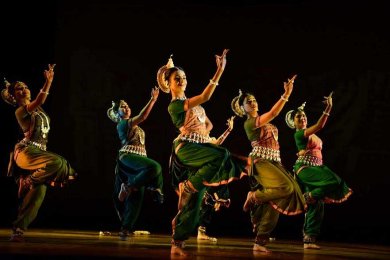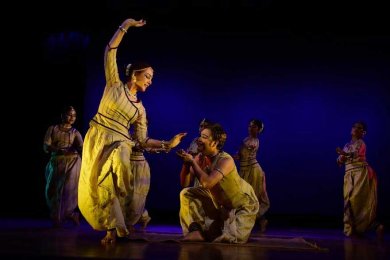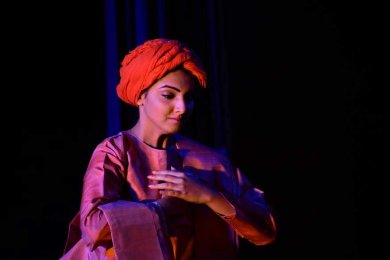
|   |

|   |
 e-mail: sunilkothari1933@gmail.com Sangam: Innovations in Odissi Photos courtesy: Ileana Citaristi September 22, 2016 Ileana Citaristi, the celebrated Odissi dancer and choreographer, explores new themes in Odissi. The latest is 'Akshara' that she choreographed for her 12th annual Sangam festival. It was presented on 13th September at Ravindra Mandap, Bhubaneswar. By a happy coincidence, during my recent visit to Bhubaneswar, I had an opportunity to watch the rehearsal of this latest choreography. She has been receiving excellent support by the noted poet Devdas Chhotray, former Vice Chancellor of Ravenshaw University. For Ileana, he has scripted 'Kaal' (Time) and 'Karuna' for her homage to Mother Teresa. Another collaboration is in terms of music. Laxmikant Palit, the renowned musician of Odisha, has set the music appropriate to the theme.
This is also the year of recognition of Odiya language as a classical language. Taking that into account her intervention has been timely. The motif has been round/circles. The poet says: "Wearing round earrings, holding chalk in hands, we are going to study. Listen to the words, bring small pieces of lime stones and draw three circles on earth. Those three circles are our world. They are our Brahma, Vishnu, Maheshwara and from those three circles all the letters will be born, which will never die, they are like our gods." But how does a child understand it? The child searches for shapes in nature, the child sees the sky as bow, the earth as a circle, sun or planets look like round earrings. The projection of sand animation shows round drawings - eyes of Lord Jagannath, Subhadra, Balaram, of Trimurti, circles of sleeping snakes, duck eggs and so on.  Akshara
From this game starts how children draw circles to learn alphabets. The Odiya script is all round to begin with. And one learns to draw perfect circles. Then the magic starts because the word of letters have a lot of fun; some of them are hiding inside, some are going hand in hand and sometimes it looks as if nobody belongs to anybody. For example, A stands for aja meaning grandfather, AA for aai meaning grandmother, OU meaning ouravata, elephant of Indra who is coming running. But the fun is O which takes children to oto, meaning camel and Odisha. KA stands for city of Cuttack. THA means thaana, alcove with 52 bazaars and 53 by-lanes, so you get completely confused in Dushara. Finally when all words have flown away remains Ksha which stands for kshama, forgiveness. The poet says representing words: "We are letters to our good friends, so do not get angry with us, we are only letters and we are earth signatures. Letters which emerged from zero are signs which never decay; they are like our gods, the letters." Ileana explored various ways in choreographing movement circles and interpreted them to suit the meaning and imagination of the poet through four dancers using Odissi dance vocabulary. The projection of sand animation complemented visuals of what dancers were performing physically using space imaginatively. The music followed the movements and the various elements coalesced well bringing freshness to the performance. This shift in thematic content was appealing whether one knew Odiya language or not. The metaphors and the play of rounds and circles and imaginative way of learning alphabets were highly entertaining. Ileana will do well to present it to various schools as visually through sand animation, Odissi dance movements and music, it has great appeal. On the occasion of Mother Teresa receiving Sainthood, Ileana to pay homage to Mother presented her choreography 'Karuna,' which conveys the compassion and essence of life of Mother. In the final sequence she shows dancers carrying sarees with borders typical of three lines which the sisters wear. Dancers do not cover their heads. It is suggestive. They walk holding sarees towards backdrop and with exquisite lighting it looks very symbolic. In the audience were present the sisters, followers of Mother Teresa. It was an apt tribute.  Mother Teresa  Tejonidhi Ileana attempts in Sangam, a confluence of dance. Besides Odissi, she presents dance troupes from other states and of different dance forms. This year she had invited Bharatanatyam guru, dancer, choreographer Dr. Swati Daithankar from Pune with her Nupurnaad troupe to present an audio visual presentation on the teachings of Swami Vivekananda. The script and choreography was by Swati Daithankar and music by Dr. Dhananjay Daithankar. It was titled 'Tejonidhi.' Swati had undertaken this project under Swami Vivekananda Kendra, Kanyakumari, and was supported by projection of visuals of Kanyakumari and nature, ocean to convey the message of Swami Vivekananda. Barring portrayal of Swami Vivekananda by a dancer in familiar robes of Swamiji, the dancer performing the main role had nothing to do except to stand and pray to the Goddess to bless him, give him vision to mankind of highest Hindu religion. There were references to his visit to Chicago, religious conference and holding high standards of religion. Swati had employed incidences of Vivekananda's prayers to the goddess where the Bharatanatyam technique was employed in flawless manner. This production also would go well with several school institutions where the Vedanta Philosophy would be made accessible to the young generation.  Dr. Sunil Kothari is a dance historian, scholar, author and critic. He is honored with Padma Shri, Sangeet Natak Akademi award and Senior Critic Award from Dance Critics Association, NYC. Post your comments Please provide your name and email id when you use the Anonymous profile in the blog to post a comment. All appropriate comments posted with name & email id in the blog will also be featured in the site. |